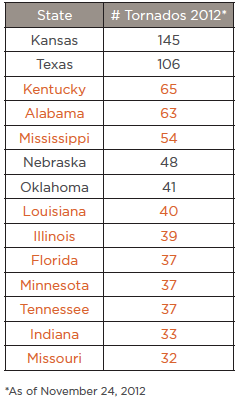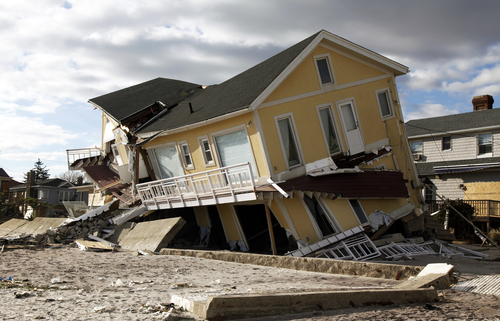Due to recent extreme weather events in the Pacific Islands, the World Bank, Japan and the Secretariat of the Pacific Community have come together to devise a two-year pilot to see whether catastrophe insurance might work such islands as Samoa, Solomon Islands, Tonga, Vanuatu and the Marshall Islands. Known as the Pacific Catastrophe Risk Insurance Pilot, it aims to reduce the vulnerability of Pacific Island States to natural disasters by improving their financial response to such events. According to Japan’s Ministry of Finance, the program “offers immediate emergency funding in the aftermath of a major disaster and will help stabilize Pacific Island economies so their efforts to respond to an emergency situation can be maximized.”
Category Archives: Natural Catastrophes
The Largest Natural Hazard Risks of 2012
2012 was a year of natural catastrophes. From Hurricane Sandy to the record-setting drought to the third most destructive wildfire season on record, the year was fraught with disasters that took a toll not only on communities nationwide, but on some of the world’s largest insurers. Today, CoreLogic issued its annual Natural Hazard Risk Summary, which details the most significant natural disasters that struck the United States in 2012. It notes the following:
Hurricanes
- The single most destructive natural disaster in 2012 was Hurricane Sandy. In late October, the Category 1 storm generated record levels of storm surge along the northern New Jersey coast and in the New York City area, impacting more than five million residents across the region.
- The first hurricane to make landfall in the U.
buy stendra online cosmeticdermcenter.com/wp-content/uploads/2023/10/jpg/stendra.html no prescription pharmacy
S. in 2012 was Category 1 Hurricane Isaac in late August, which caused an estimated $2 billion in insured losses around the New Orleans metro area.
Floods
- Flood losses are expected to total approximately $10 billion in 2012, which would result in the third consecutive year of increasing flood damage in the U.S.
- Earlier in the year, Tropical Storm Debby tracked slowly across the Florida peninsula in June, dropping at least 25 inches of rainfall along its path.
- After months of sustained, widespread drought, Hurricane Isaac brought heavy rainfall and flooding to Louisiana in late August before continuing northward into the Midwest.
buy arimidex online cosmeticdermcenter.com/wp-content/uploads/2023/10/jpg/arimidex.html no prescription pharmacy
Wildfires
- The 2012 wildfire season was the third most destructive on record in the U.S. in terms of total acres burned as of early December.
- The 15-year trend of fewer, but larger fires continued into 2012 with fewer than 51,000 individual wildfires across the country—the lowest number recorded since 1989.
- Several of the individual fires that occurred in 2012 set records, including Colorado’s Waldo Canyon Fire, which damaged or destroyed 346 homes, and New Mexico’s Whitewater-Baldy Fire, which burned more than 297,000 acres.
- NOAA continues to predict a pattern of drought conditions through the start of 2013, suggesting the potential for another increase in wildfire risk across much of the country. In the chart below, “SL” stands for short-term drought (typically less than six months) and “L” stands for long-term drought (typically more than six months).
Tornadoes
- Tornado activity in 2012 was not strictly limited to the region commonly referred to as “Tornado Alley.” States located outside the central and southern Great Plains experienced a significant number of tornadoes this year. The chart below, from CoreLogic’s report, represents states with 30 or more tornadoes in 2012. States in orange are not typically considered part of “Tornado Alley.”
- January 2012 was one of the most active Januaries since recording began in 1950, with a total of 79 tornadoes reported across the country.
- In late February, tornadoes struck Illinois, Indiana, Kentucky and Ohio. Harrisburg, Ill., experienced the most concentrated destruction, with more than 225 homes and businesses damaged or destroyed and an estimated $475 million in total damage.
“Because the strength, severity and geographic impact of natural disaster events will change from year to year, an understanding of patterns in hazard activity, geographic vulnerabilities and the properties exposed to each different type of disaster is crucial to managing risk,” said Dr. Thomas Jeffery, senior hazard scientist for CoreLogic.
As we’ve seen with the natural catastrophes of 2012, it is important for insurers, homeowners and businesses to develop a more comprehensive evaluation of risk — one that includes typically non-traditional locations.
A Perfect Storm of Insurance Coverage Problems
Businesses surviving Superstorm Sandy’s wrath will have another storm to endure, thanks to their insurance companies. Under many business property insurance policies, insurers may argue that some types of damage caused by Sandy are excluded. For example, some components of Sandy such as wind and rain damage may be covered causes of loss, while storm surge and flood may be excluded altogether, or may be covered only with lower limits and higher deductibles. Superstorm Sandy, much like Hurricane Katrina, included multiple perils, some of which likely are specifically covered, but some of which may arguably be excluded. Moreover, even if a business was affected by only one type of damage (flood, for example), that damage likely was precipitated by another cause, such as storm surge, wind and rain.
So, who wins in this epic battle? The answer may depend upon which state’s law will control the issue. Many states have adopted an “efficient proximate cause” test to determine coverage when there are both covered and excluded perils contributing to a loss.
Efficient proximate cause, however, has no set meaning and courts interpret the test differently.
Some courts view it as the “dominant” or “predominating” cause, while others see it as the risk that sets other causes or a “train of events” in motion. Some courts find that either the first or the last event can be the proximate cause. Without uniformity under state law, policyholders are left unsure as to whether their losses will be covered.
To make matters worse, some policies contain what is known as an “anti-concurrent causation” provision, which provides that the insurance company will not pay for loss caused by an excluded peril, even if a covered loss contributes directly or indirectly or in any sequence to the loss. Through this clause, the insurance company may seek to avoid coverage entirely if there is but one potentially excluded cause in the mix.
buy penegra online https://royalcitydrugs.com/penegra.html no prescription
This has enabled the insurance companies to contract around the efficient proximate cause doctrine. While some states allow an attack on this provision, the majority of states hold that such a clause is valid and enforceable.
Further complicating the problem is the ensuing loss clause found in some policies, which carves back coverage for a loss from a covered peril that follows as a consequence of an excluded peril. For example, if a policyholder suffers loss from an excluded cause, such as flood, but the building is consumed by fire shortly after (which happened in the case of Superstorm Sandy to a number of structures), then the loss should be covered.
With Superstorm Sandy it is likely that insureds with these policy provisions will remain uncertain as to their coverage for some time to come.
S&P Sees Uncertainty in Sandy Loss Estimates
Superstorm Sandy wreaked havoc not only on the people of the tri-state area, but also on insurance companies. In a recent edition of Credit Matters, a talk show produced by Standard & Poor’s, Taoufik Gharib, director of S&P’s insurance sector, discusses the insurance lines most affected by Superstorm Sandy, the uncertainty that remains in industry loss estimates and the potential for ratings action that may still result.



